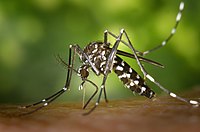
Photo from wikipedia
Using collection methods for Aedes adults as surveillance tools provides reliable indices and arbovirus detection possibilities. This study compared the effectiveness of different methods for collecting Ae. aegypti and Ae.… Click to show full abstract
Using collection methods for Aedes adults as surveillance tools provides reliable indices and arbovirus detection possibilities. This study compared the effectiveness of different methods for collecting Ae. aegypti and Ae. albopictus and detecting arboviruses circulating in field-caught female specimens. Collection sites were defined in urban, peri-urban, and rural landscapes in two Brazilian cities. Collections were performed using Adultraps (ADT), BG-Sentinel (BGS), CDC-like traps (CDC), and indoor (ASP-I) and outdoor (ASP-O) aspiration during the rainy and dry seasons of 2015 and 2016. Generalized linear mixed models were used to model the effectiveness of each collection method. A total of 434 Ae. aegypti and 393 Ae. albopictus were collected. In total, 64 Ae. aegypti and sixteen Ae. albopictus female pools were tested for DENV, CHIKV, ZIKV, or YFV; none were positive. Positivity and density were linear at low densities (<1 specimen); thereafter, the relationship became non-linear. For Ae. aegypti, ADT and CDC were less effective, and ASP-I and ASP-O were as effective as BGS. For Ae. albopictus, all collection methods were less effective than BGS. This study highlights the need for an integrated surveillance method as an effective tool for monitoring Aedes vectors.
Journal Title: Tropical Medicine and Infectious Disease
Year Published: 2022
Link to full text (if available)
Share on Social Media: Sign Up to like & get
recommendations!